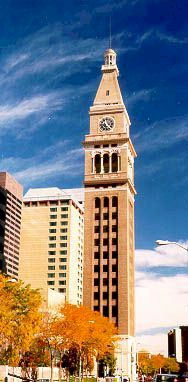Grant News
A Towering Preservation Achievement
Colorado History NOW’s “Do you know this building?” feature has always been popular among readers. With apologies to Holly Wilson—the column’s regular author—for stealing the idea, here’s a bonus puzzler: This structure’s gold-leafed dome brightens Denver’s modern skyline. At night, its lighted profile attracts swarms of shutterbugs. Its history reflects the development of its neighborhood, city, and state. But this landmark is not Colorado’s capitol building.
Like the capitol, the Daniels and Fisher Tower deserves recognition as one of the most architecturally significant structures in Denver. The flag flies 372 feet above ground, a height that earned the tower a number-three ranking among the nation’s tallest buildings at the time of its construction. Only New York City’s Metropolitan Life and Singer towers were taller. Department store owner William C. Daniels, its builder, wanted to give Denver something “that the whole city could point to with pride.” Finished in 1911 and modeled after the famous campanile of St. Mark’s in Venice, it rises twenty-two stories from the corner of Sixteenth and Arapahoe Streets. Because St. Mark’s was being restored at the time of the tower’s completion and was technically “under construction,” the Denver Times could print the dubious headline, “Venetians Erecting a Column Almost Exact Replica of D&F’s Tower in Denver.”
Now it is the D&F Tower’s turn to be restored. Though it lost its attached department store during Denver’s dark age of urban renewal, the tower itself has never lacked supporters. The Daniels and Fisher Tower Preservation Foundation cares for those portions of the building that benefit the public, including the lobby, cupola, two-and-a-half-ton bell, dome, flagpole, and the entire façade (encumbered by a preservation easement held by the Colorado Historical Foundation). Everyone, from architects to downtown businesses to folks having lunch in its shadow on a sunny day, believes that the tower has become part of the city’s public landscape. Even the Denver Urban Renewal Authority, the city agency that tried to demolish the tower, incorporated its likeness into its official logo.
The State Historical Fund, established by Coloradans to foster the preservation of that landscape, has earned a place among the tower’s biggest supporters. In 1995, the Fund granted the D&F Preservation Foundation $100,000 to restore the landmark’s steel superstructure and pyramidal spire. Since then, the Fund has allocated another $405,000 to restore all of the tower’s publicly accessible and visible spaces, from the foundation to the flagpole.
During the most recent phase, preservationists cleaned and repaired exterior brickwork, metalwork, and terra cotta tiles; finished restoring the lobby; and installed a display interpreting the history of the building and its restoration. Bill Moon, from David Owen Tryba Architects, was the project architect, Building Restoration Services completed the exterior work, Dan Bassett restored the lobby’s marble walls, and historian Barbara Gibson did the historical interpretation. Richard Hentzell, of the D&F Preservation Foundation, has been the project’s director since 1994.
Many other craftspeople, historians, tenants, and architecture aficionados have dedicated months, and sometimes years, to the building’s preservation. But none can match the original owner’s love for the landmark. In 1981, restoration workers discovered a safe on the tower’s fourth floor containing an urn holding the cremated remains of William C. Daniels. Upon further investigation, the building’s current owners discovered Daniels’s will, which instructed heirs to leave a portion of his remains in the tower he built. After being shuffled around among the Daniels and Fisher Store’s legal successors, the urn found its way back to the tower. Now on display in the lobby’s historical exhibit, it memorializes one man’s commitment to his business, his building, and his city.

